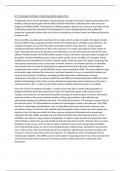Summary
Summary Ac 1.4 Evaluate methods of collecting statistics about crime
- Module
- Crime Scene to Courtroom
- Institution
- WJEC
These are my answers that I used to achieve a near perfect 98/100 on my Year 13 Criminology controlled assessment. I changed it as needed during the exam but this is the backbone of my work
[Show more]




